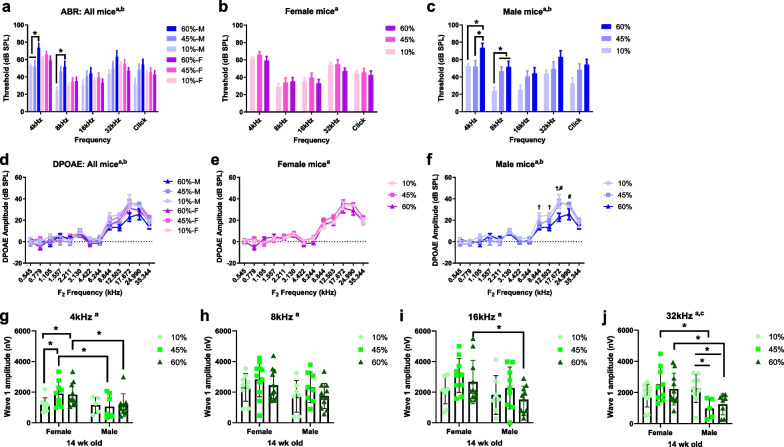Fig. 2.
Male mice are more vulnerable to HFD-induced hearing loss. a Auditory sensitivity was evaluated by auditory brainstem response (ABR) threshold in all mice (a) at 14 weeks of age (10 weeks of diet treatments). Two-way ANOVA. amain effect of frequency (F(4, 222) = 21.24, p < 0.0001); bmain effect of diet (F(5, 222) = 6.941, p < 0.0001). b Female mice showed no significant differences in ABR threshold between diet groups. aMain effect of frequency. c HFD-fed (60 kcal% fat) male mice presented significantly decreased hearing sensitivity (increased ABR threshold) at 4- and 8-kHz frequency compared to other diet groups. amain effect of frequency; b, main effect of diet, p < 0.05. n = 6–10. d Distortion product otoacoustic emissions (DPOAE), an indirect measure of outer hair cell (OHC) function, were recorded from mice in all treatment groups at 14 weeks of age. DIO impaired outer hair cell function in males, but not in females. e Female mice had no significant reduction in DPOAE amplitudes in all treatment groups relative to baseline (F(2,351) = 5.145, p = 0.0063; p > 0.05 for all multiple comparisons). f HFD-fed (60 kcal% fat) male mice impairs outer hair cell function. Two-way ANOVA. aMain effect of frequency, F(12, 273) = 51.29, p < 0.0001; bmain effect of diet, F(2, 273) = 7.707, p = 0.0006; cinteraction, F(24, 273) = 1.436, p = 0.0892; †, 10% vs. 60%; #, 45% vs. 60%. g–i Sex differences in auditory nerve function. ABR wave I amplitudes (a sensitive measure of auditory nerve function) were elicited by tone pips (90 dB) at 4 (g), 8 (h), 16 (i), and 32 (j) kHz at 14 weeks of age. n = 8–11. Asterisk indicates p < 0.05. amain effect of sex; bmain effect of diet; Two-way ANOVA; Tukey's multiple comparisons test

